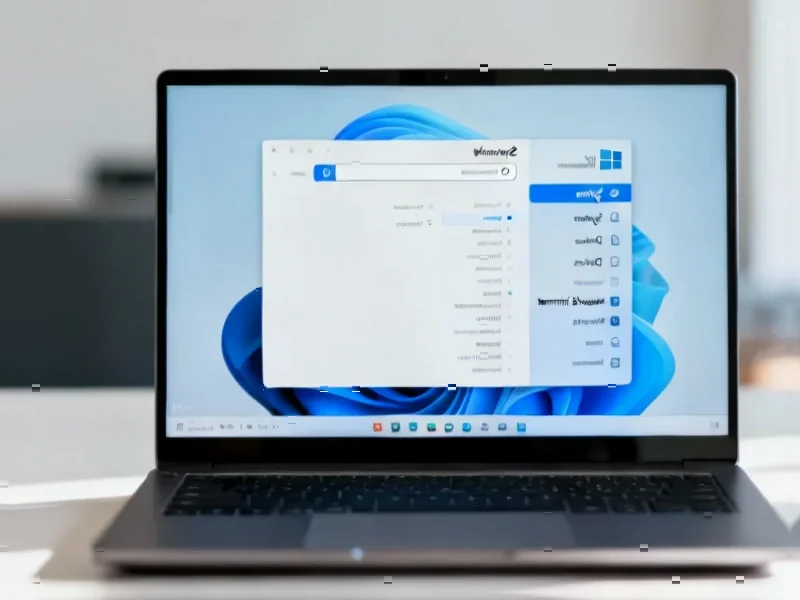According to engadget, Meta’s Mixed Reality Link feature for Windows 11 is now available to all users after initially launching on a limited basis last year. The technology enables Meta Quest 3 and Horizon OS users to pair their headsets with Windows 11 PCs, creating a virtual desktop environment that supports multiple high-resolution monitors. The system also integrates with cloud-based solutions including Windows 365 Cloud PC, Azure Virtual Desktop, and Microsoft Dev Box. The price differential is striking – Meta Quest 3 starts at $300 compared to Apple Vision Pro’s $3,500 entry point, making virtual productivity significantly more accessible. This rollout comes as Meta continues heavy investment in mixed reality technology, including recent teasers of future headsets promising near-photorealistic VR experiences.
Table of Contents
The Virtual Productivity Revolution
What makes this partnership between Meta and Microsoft particularly significant is how it addresses the fundamental challenge of workspace limitations. Traditional physical monitors have inherent constraints – they’re expensive, space-consuming, and immobile. The ability to create multiple high-resolution virtual displays through a VR headset represents a paradigm shift for knowledge workers, especially those in data-intensive fields like software development, financial analysis, or media production. The integration with cloud services like Azure Virtual Desktop means users aren’t tethered to powerful local hardware – they can access robust computing resources from anywhere, with the headset serving as their portable workstation interface.
The Accessibility Gamble
Meta’s $300 price point for the Quest 3 versus Apple’s $3,500 Vision Pro creates an entirely different market dynamic. While Apple targets premium enterprise and professional users who might expense the device, Meta is positioning virtual productivity as something accessible to students, freelancers, and everyday remote workers. This democratization strategy could accelerate adoption rates dramatically. However, there are significant questions about whether the Quest 3 hardware can deliver the seamless experience needed for extended work sessions. Battery life, comfort during prolonged use, and display resolution for text clarity remain practical concerns that early adopters will need to evaluate.
The Microsoft’s Ecosystem Play
For Microsoft, this represents another strategic move to ensure Windows 11 remains relevant in an increasingly platform-agnostic computing landscape. By making their operating system the backbone of emerging mixed reality productivity environments, they’re securing their position regardless of which hardware platform dominates. The integration with Microsoft’s cloud services creates a compelling ecosystem lock-in – users who adopt this workflow will naturally gravitate toward Azure, Windows 365, and other Microsoft cloud offerings. This is particularly clever timing as Apple’s Vision Pro represents a potential threat to Microsoft’s desktop dominance should spatial computing become the next major platform.
Technical and Adoption Challenges
The success of Mixed Reality Link will depend heavily on solving practical workflow issues that have plagued previous attempts at VR productivity. Text rendering in virtual environments has historically been problematic, with issues like screen door effects and subpixel rendering causing eye strain. The ergonomics of wearing a headset for eight-hour workdays present another hurdle – current generation headsets remain relatively heavy and can cause discomfort over extended periods. There’s also the social acceptance factor – will companies embrace employees working in virtual environments during meetings and collaborative sessions? These aren’t trivial challenges, and they’ve stalled similar initiatives in the past despite promising technology.
Competitive Landscape Implications
This development signals a fundamental strategic divergence between Meta and Apple in the mixed reality space. Apple is pursuing a high-end, premium experience with the Vision Pro, while Meta is opting for mass-market accessibility. Both approaches have merit, but Meta’s partnership with Microsoft gives them immediate access to the world’s largest productivity software ecosystem. The timing is also noteworthy – by establishing this beachhead before Apple’s Vision Pro gains significant market traction, Meta could effectively define what “mixed reality productivity” means for the majority of users. If successful, this could force Apple to reconsider its exclusively premium positioning or accelerate development of more affordable Vision product lines.
The Future Workplace Transformation
Looking forward, the success of technologies like Mixed Reality Link could fundamentally reshape how we think about remote work infrastructure. Instead of companies shipping physical monitors and docking stations to employees’ homes, they might provide standardized headsets that create virtual workspaces anywhere. This has implications for real estate (smaller home offices needed), mobility (work from anywhere with decent internet), and collaboration (shared virtual spaces rather than video calls). However, the transition will require not just technological maturity but also cultural adaptation. The companies that successfully navigate both the technical and human factors of this shift will likely define the next generation of workplace technology.



